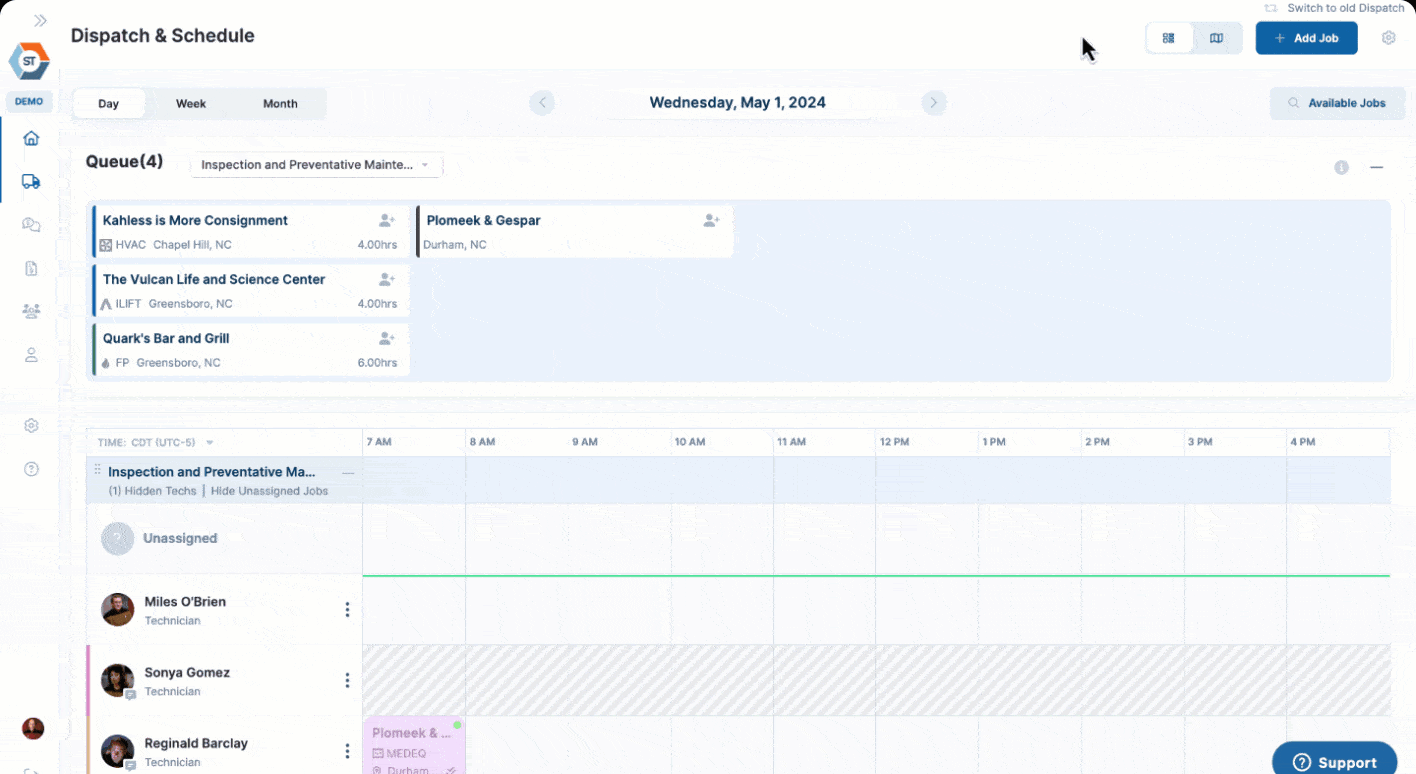Choosing and Implementing HVAC Dispatching Software
Efficient dispatch management is crucial for any business, but it is particularly important for commercial HVAC companies. Dispatching software for HVAC companies can improve efficiency, streamline operations, reduce errors, and enhance customer satisfaction. This article will discuss the key features and benefits of HVAC dispatching software and provide actionable insights and tips for deploying dispatching software in HVAC businesses of all sizes.
Features of HVAC Dispatching Software
Real-time scheduling and dispatching: One of the primary features of dispatching software is real-time scheduling and dispatching. This feature enables dispatchers to schedule technicians, assign jobs, and send work orders to field personnel in real-time. This not only improves the efficiency of the dispatch process but also enables businesses to respond more quickly to customer needs.
- Integration with Customer and Job Information: Dispatching software also typically includes integration with customer and job information. This feature allows dispatchers to quickly access customer information, job history, and other essential details to make informed dispatch decisions. This integration also helps improve communication between dispatchers, technicians, and customers, leading to enhanced customer satisfaction.
- Mapping Features: Mapping features are another critical component of dispatching software. These tools enable dispatchers to assign jobs to the closest available technician, optimize routes to maximize efficiency, and provide real-time traffic updates. Mapping features can improve the overall response time, reduce travel time, and minimize fuel costs for your business.
- Communication Tools: Efficient communication is crucial for effective dispatch management. Dispatching software includes communication tools that enable dispatchers and technicians to stay connected throughout the job assignment process. These tools can include messaging features, voice and video capabilities, and email notifications.
- Employee Tracking and Management: Dispatching software includes tools for tracking and managing employees, such as time tracking, job status updates, and performance monitoring. These features help businesses manage their technicians’ workload, monitor performance, and identify areas for efficiency improvements.
- Mobile Application: Many dispatching software solutions also offer mobile applications, allowing technicians to access job information, view schedules, and receive updates while out in the field. Mobile applications can also include tools for capturing job information, recording time on site, and processing payments, enabling technicians to work more efficiently and accurately.
Benefits of Using HVAC Dispatching Software
HVAC dispatching software offers numerous benefits for businesses in the HVAC industry. This section will explore the advantages of implementing dispatching software and how it can significantly improve the efficiency and effectiveness of your HVAC company’s operations. From enhanced communication and collaboration to increased productivity and cost reduction, HVAC dispatching software can revolutionize your dispatch management process and deliver exceptional customer service. The following subsections outline some of the key benefits of HVAC dispatching software.
Improved Communication and Collaboration
Dispatching software improves communication and collaboration between dispatchers, technicians, and customers. With real-time access to job details, job history, and customer information, dispatchers can quickly and accurately assign jobs to the most appropriate technician, ensuring efficient and effective service delivery. Improved communication leads to increased customer satisfaction and loyalty.
Increased Efficiency and Productivity
Dispatching software automates many tasks in the dispatch process, which can significantly increase efficiency and productivity. Quick access to customer details, optimal route planning, and real-time updates on job status, tools, and parts needed means that technicians can complete more jobs in less time, improving overall productivity and profitability.
Enhanced Customer Service
Dispatching software helps businesses quickly and accurately respond to customer needs. Real-time access to job details and job history combined with accurate scheduling ensures that jobs are assigned to the most appropriate technician, reducing customer wait times and enhancing the overall customer experience.
Resource Optimization and Cost Reduction
Dispatching software can optimize resources and reduce costs by maximizing technician efficiency. Mapping features optimize scheduling and routes for better fuel efficiency and quicker responses to job requests. Similarly, using dispatching software to monitor employee performance, track job completion time, and log expenses creates opportunities to reduce costs.
Real-Time Monitoring and Reporting
Dispatching software provides real-time monitoring and reporting, enabling businesses to respond quickly to changing situations and improve overall decision-making. The software also generates reports that help businesses identify trends, improve operations, and increase efficiency.
Choosing the Right HVAC Dispatching Software
Selecting the right HVAC dispatching software is a critical decision that can have a significant impact on the efficiency and success of your business. With a variety of options available in the market, it’s essential to carefully evaluate and choose a dispatching software that aligns with your business needs and goals. This section will guide you through the process of choosing the right HVAC dispatching software, from identifying your specific requirements to researching available options and considering integration with existing systems. By following these steps and making an informed decision, you can ensure seamless implementation and maximize the benefits of dispatching software for your HVAC company.
- Identifying the Specific Needs of Your Business: One of the critical steps in selecting the right dispatching software is identifying what the business needs are. A thorough analysis of your business requires the assessment of the volume workload, the size of the company, and most importantly, the existing business model and processes.
- Researching Available Options and Vendor Reputation: Another essential aspect of choosing HVAC dispatching software is researching available options and vendor reputation. Researching will help you identify which solutions are available in the market, enabling you to select the one that fits your business requirements. Similarly, pay attention to the vendor’s reputation, product reviews, and customer service quality.
- Assessing Integration with Current Systems: Planning for integration with the existing systems is crucial to leverage the full potential of dispatching software. It is essential to consider the hardware and software systems required to host and access the system seamlessly.
- Evaluating User-Friendliness and Training and Support Offering: User-friendliness is a crucial factor in the selection process. The system should be intuitive, easy to navigate, and have a friendly user interface. Moreover, it is necessary to determine the training and support offerings to get your staff comfortable with the software.
Implementing HVAC Dispatching Software
Establishing effective communication and buy-in from employees: Employee cooperation is of the utmost importance to successfully implement dispatching software. To ensure employee buy-in and successful implementation, it is essential to communicate the benefits of the system, address employees’ concerns and provide adequate training and support.
Successful implementation requires addressing technical considerations and potential obstacles upfront, such as infrastructure needs, data security, and the possibility of technical glitches. Identifying these technical considerations will help the company protect against any potential risks.
Training and certification are essential for effective implementation. A well-designed training program that includes how to navigate the system seamlessly, keep track of the time, obtain work documentation, and create service invoices is necessary for field technicians. Additionally, follow-up and refresher courses should be offered on a regular basis.
The implementation process does not stop at deployment. Regularly monitoring and tracking the software’s performance will enable businesses to identify where issues occur and make necessary changes to ensure efficient dispatching operations.
Actionable Insights and Tips for Success
To maximize the benefits of dispatching software, it is necessary to set achievable goals and metrics that can be measured regularly. These goals and metrics can include streamlining dispatching operations, reducing response time to service requests, and improving customer satisfaction ratings. By setting specific goals that align with your business needs and regularly measuring progress, you can track improvements and identify areas for continuous improvement.
Employees’ input is crucial in making the most out of dispatching software. Prioritizing employee engagement and empowerment can help motivate employees and increase buy-in into the software. To encourage employee buy-in, provide adequate training and support to help them understand how the dispatching software works and how it can benefit their day-to-day job functions. Involving employees in the software selection and implementation process can also help build employee confidence and ensure that the software meets their needs. By prioritizing employee engagement and empowerment, you can foster a culture of efficiency and collaboration that maximizes the benefits of dispatching software.
Furthermore, dispatching software must evolve with the business’s changing needs. Being open to continuous improvement and adaptation can help keep dispatching operations performing optimally. Regularly reviewing the dispatching process and identifying areas for improvement can help keep operations efficient and ensure that the software is meeting its intended goals. As the business grows and its needs change, it may be necessary to re-evaluate the dispatching software and look for other options or additional features that better align with the company’s needs. By being open to continuous improvement, businesses can stay ahead of the curve and adapt to evolving industry trends and customer needs.
Dispatching software can revolutionize dispatch operations for any HVAC business. By investing in an effective dispatching software system, HVAC companies can improve communication, increase efficiency and productivity, enhance customer service, optimize resources, and reduce costs. Proper research, planning, implementation, training, and deployment can lead to seamless operations, successful outcomes, and ultimately, maximizing customer satisfaction.
Learn about ServiceTrade’s HVAC software here.

